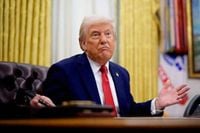Bitcoin (BTC) reached new April highs at the April 2 Wall Street open as markets braced for US "Liberation Day." Data from Cointelegraph Markets Pro and TradingView showed local highs of $86,444 on Bitstamp, marking the best performance for BTC/USD since March 28. Volatility surrounded the cryptocurrency in the lead-up to US President Donald Trump’s announcement of a sweeping round of reciprocal trade tariffs.
The measures were unveiled in an address from the White House Rose Garden at 4 PM Eastern Time, with Trump subsequently holding a press conference. While US stocks traded slightly down after the open, Bitcoin managed to claw back lost ground, acting in a key area of interest filled with long-term trend lines. As Cointelegraph reported, these included various simple (SMA) and exponential (EMA) moving averages, among them the 200-day SMA — a classic bull market support line currently lost.
In his latest observations, popular trader and analyst Rekt Capital made additional reference to the 21-week and 50-week EMAs, noting, "The consolidation between the two Bull Market EMAs continues. However, the 21-week EMA (green) represents lower prices as it declines." He highlighted that this week, the green EMA represents $87,650. The declining nature of this EMA will make it easier for $BTC to breakout.
Rekt Capital flagged more bullish news in the making, as BTC/USD attempted to break out of an extended downtrend on daily timeframes. He confirmed, "Bitcoin is one Daily Candle Close above & retest of the Downtrend away from breaking out into a new technical uptrend." This analysis coincided with Bitcoin’s daily relative strength index (RSI) metric breaking free from its own downtrend that had persisted since November 2024.
However, the macro picture appeared less optimistic. Trading firm QCP Capital expressed skepticism, stating that risk assets were likely to remain under pressure following the tariffs announcement. They summarized, "In crypto, sentiment remains broadly subdued. BTC continues to trade without conviction, while ETH is holding the line at $1,800 support. Across the board, crypto markets are showing signs of exhaustion with numerous coins down 90% YTD, with some shedding over 30% in the past week."
Previous tariff moves in Q1 almost unanimously delivered downward BTC price reactions, leaving many traders cautious. Other industry participants, however, were more hopeful. Asset management firm Swissblock argued that there was "no sign of an imminent collapse" occurring on Bitcoin. In an X thread on March 31, they queried, "Will $BTC hold as a hedge, or follow TradFi into a pullback?" describing BTC price action as being "at a crossroads."
Swissblock also saw the potential for a return to $76,000 multimonth lows in the event of a negative reaction — a drop of 11% versus current levels. As the market reacted to the news, Bitcoin's price swung between gains and losses, briefly spiking as much as 3.2% in the minutes following Trump's remarks.
As the dust settled from the tariffs announcement, traders were left to ponder the implications for Bitcoin and the broader cryptocurrency market. With many coins already showing significant losses year-to-date, the question remained whether Bitcoin could maintain its recent gains or if it would follow the trend of other risk assets under pressure from macroeconomic factors.
As Bitcoin continues to navigate a complex landscape marked by regulatory changes and market sentiment, analysts are keenly watching for any signs of a reversal or further downturn. With the cryptocurrency market often mirroring traditional financial markets, the outcome of Trump's tariffs could set the tone for Bitcoin's performance in the coming weeks.
This article does not contain investment advice or recommendations. Every investment and trading move involves risk, and readers should conduct their own research when making a decision.




